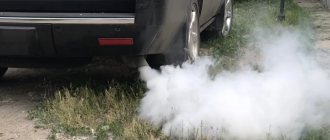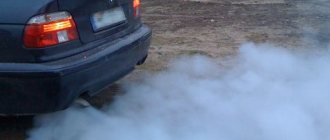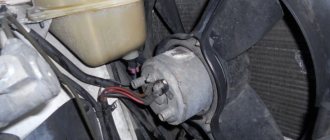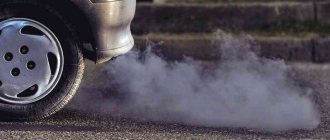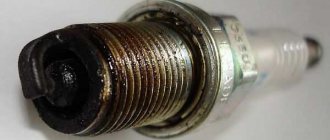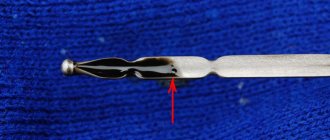White smoke from the exhaust pipe is a common occurrence in winter, so, as a rule, few people pay attention to it, but in the summer, when it is warm, thick white exhaust is alarming, both for owners of diesel cars and cars with a gasoline engine. Let's figure out why white smoke appears from the exhaust, whether the reasons are dangerous , and how to find out its origin .
Harmless smoke, or rather white steam, should not have a special odor, since it is formed due to the evaporation of accumulated condensate in the exhaust system pipes and in the engine itself at an air temperature below +10°C. Therefore, it should not be confused with smoke, which will indicate problems in the cooling system or the engine itself.
White smoke is a sign of increased humidity in the exhaust system
. After the engine warms up, the steam and condensate disappear, but if smoke still comes out of the exhaust, then this is a sign of engine malfunction.
The smoke coming from the muffler should be colorless
.
White smoke from exhaust cause
Most problems that cause white smoke from the exhaust pipe are caused by engine overheating or poor fuel supply. By paying attention to the shade of smog, its smell and the general behavior of the car, you can accurately determine the cause of the smoke. The most common are:
- Presence of moisture.
- Presence of water in fuel.
- Incorrect operation of the injection system.
- Incomplete combustion of fuel.
- Coolant entering the cylinders.
It is worth noting that some of the reasons why dangerous white smoke appears from the exhaust pipe of a diesel engine and the exhaust pipe of a gasoline engine may have different origins, so let’s deal with everything in order, and separately.
To diagnose your car, you can follow one “experienced” method:
- warm up the car to operating temperature;
- take a white sheet of paper and apply it to the exhaust pipe for 10-15 seconds (do not block the exhaust pipe completely);
- look at the paper - if it is wet from water, there is no breakage, but if the paper is oily, this means that antifreeze or antifreeze is leaking into the system.
Another reason for thick white smoke may be a clogged engine air filter. As soon as there is less air due to a clogged filter, and there is more fuel, smoke appears. However, in this case, the smoke can be either white or black.
If you find white smoke from the exhaust pipe in your car, under no circumstances should you continue to operate the car, as the defects progress quickly, and operating the engine in such conditions leads to rapid wear of parts. Thus, after just a few hundred kilometers, major repairs may be required.
You can buy all the necessary spare parts in the IXORA . Qualified managers will definitely help you make the right choice and answer all your questions. Contact us, it’s profitable and convenient.
| Manufacturer | Detail number | Name |
| CHERY | A111109111AB | Air filter Chery MB W124 |
| GREAT WALL | 1109102K00 | Air filter MITSUBISHI 3000GT |
| LIFAN | S1109160 | Air filter LIFAN X60 |
| CHERY | T111109111LA | Air filter CHERY TIGGO |
| LYNX | LC1610 | Oil filter for Ford Mondeo V |
| MANDO | MOF4476 | Oil filter for Suzuki Swift |
| RENAULT | 152085758R | Oil filter Renault Fluence |
| FILTRON | OP6163 | Oil filter for Audi A4 |
* Please check the applicability of parts specifically for your car with our managers by phone (calls within Russia are free).
White smoke from the exhaust pipe of a diesel engine
White exhaust during the warm-up mode of a working diesel engine is quite normal. But after the engine has reached operating temperature, such smoking may indicate:
- Condensation in solarium.
- Incomplete combustion of diesel fuel.
- Fuel overflow due to malfunction of injectors.
- Coolant leaking into the manifold.
- Low compression.
It is also worth noting that in vehicles with a FAP/DPF particulate filter, white smoke may appear from the muffler when soot particles are burned.
To diagnose a specific cause, you need to follow a few simple steps:
- First, check the color of the smoke , is it pure white or has some tint (bluish smoke will indicate burnt oil).
- Secondly, check the coolant level for the presence of exhaust gases and the presence of oil in the cooling system.
A whitish-gray exhaust when warming up may indicate untimely ignition of the mixture . This color of smoke indicates that the gases that were supposed to push the piston in the cylinder ended up in the exhaust pipe. Such smoke, as well as with the evaporation of moisture, disappears after warming up, if everything is in order with the ignition of the car.
Symptoms of a burnt cylinder head gasket
The presence of thick white smoke even after warming up indicates that coolant has entered the engine cylinder . The place where liquid penetrates can be either a burnt gasket or a crack . You can check the theory of coolant entering from the cooling system in this way:
- opening the cap of the expansion tank or radiator, you will see an oil film;
- you may smell exhaust gases from the tank;
- bubbles in the expansion tank;
- the fluid level will increase after starting the engine and decrease after stopping it;
- Pressure increases in the cooling system (can be checked by trying to compress the upper radiator hose when starting the engine).
If you notice signs of coolant getting into the cylinders, then further operation of the faulty engine is not recommended , since the situation can quickly worsen due to a decrease in the lubricating properties of the oil, which gradually mixes with the coolant.
Antifreeze in engine cylinders
When white exhaust is harmless and there is no need to panic
White smoke that appears when starting the engine in cold weather should not alarm the driver. This only indicates the evaporation of condensate. After the engine warms up, the exhaust disappears, since all the excess moisture inside the exhaust system pipes evaporates.
The lower the ambient temperature, the slower the car will warm up. Therefore, puffs of white smoke from the chimney under such conditions are normal.
It should be taken into account that during short city trips in winter, small engines with a turbine do not have time to warm up well. Therefore, cars with such power units smoke constantly. During the cold season, drops of condensation often flow from the exhaust pipe. Such phenomena can also be considered quite normal.
White smoke from the exhaust pipe of a gasoline engine
As stated earlier, the release of white steam from the exhaust in cold and humid weather is a completely natural phenomenon; before warming up, you can even see it dripping from the muffler, but if the engine is at an optimal temperature, and steam continues to escape, then you can be sure that the engine there are problems.
The main reasons why white smoke comes out of the exhaust pipe of a gasoline engine are:
- Leaking coolant into the cylinder.
- Injector malfunction.
- Low-quality gasoline with foreign impurities.
- Burnout of oil due to the presence of rings (smoke with a tint).
The reasons why white smoke may appear from the exhaust of a gasoline car may only partially differ from those affecting a diesel engine, so we will pay more attention to how to check exactly why the smoke began to pour out.
Black smoke
The appearance of black smoke from the exhaust pipe does not indicate a major breakdown of the engine or other systems. But if the cause of this phenomenon is not eliminated in a timely manner, then this can really lead to serious problems with the engine, ignition system and supply system.
The formation of black smoke indicates an oversaturated fuel-air mixture. Such a large amount of fuel enters the cylinders that it does not have time to burn effectively, which is why the exhaust becomes dark in color. Such exhaust is much more toxic than the ordinary exhaust of a properly running car.
The main cause of black smoke is a malfunctioning fuel supply system. The reason may also be a malfunction of the ignition system, as a result of which the fuel does not ignite inside the chamber, which is why the mixture comes out in a raw state through the muffler. Another characteristic of such a case is that the engine will “trouble” a lot.
If the exhaust is gray-black, this may indicate that the carburetor is not working properly. Often the reason lies in the overflow of the float chamber.
- This may occur due to a faulty needle valve, which may allow excess fuel to pass through or, on the contrary, stick.
- The jets may be clogged.
To fix such problems, you need to disassemble the carburetor and clean it thoroughly. If this does not help, then you should buy a repair kit, replace the jets and needle valve and correctly set the gasoline level inside the chamber.
In the case of an injection engine, the problem can be solved by cleaning the injector itself. It may also be necessary to replace the fuel pump or one of the sensors that monitor various cycles. In the second case, it is unlikely that you will be able to solve the problem on your own; you will have to go to a workshop, where, using special equipment, they will be able to correctly diagnose the faulty element and replace it.
From novice drivers you can often hear questions related to exhaust, and specifically about why the car produces so much smoke. This mainly concerns the formation of thick white smoke, which can appear in the morning when the driver starts a cooled engine, but white smoke can also appear while the car is moving.
Smoke “on cold”
The presence of smoke when starting a cold engine for the first time in the morning is not always a symptom of a malfunction. If it is white, then it is just condensation vapor, which was mentioned above.
Even bluish smoke is considered quite normal if the engine is really cold. It indicates that the parts of the piston group have not yet warmed up and have not expanded, that is, there is a microscopic gap between them. Through it, a little oil enters the combustion chambers, the combustion of which manifests itself in the form of a gray or blue haze. As the engine warms up, it should disappear. This is the norm.
Black smoke “when cold”, if it disappears after warming up, also does not bode well. Unless there are some problems in the engine power supply system. Very often, devices responsible for “warm-up speed” fail. If they are “dead” or do not work correctly, then a too rich air-fuel mixture is simply supplied to a cold engine. Enriched is when there is not enough oxygen for complete combustion of a portion of gasoline. It is unburned fuel that gives off black smoke at the start.
Why this problem cannot be ignored
If white smoke comes from the exhaust pipe, which is a consequence of a malfunction of some vehicle elements in the internal combustion engine, you must act quickly. Mixing antifreeze and oil is a useless emulsion that has low lubricating properties. A protective film still forms on the cylinder walls, however, it is not of the required quality. All this leads to the formation of carbon deposits, burnout of cooling and lubricants and rapid wear of various structural elements. If no action is taken, the engine will run almost dry, which will sooner or later lead to a wedge.
The main causes of the problem
Cold weather
If thick white smoke comes out of the exhaust pipe, the reasons may be different. Low air temperature is one of them. As noted earlier, water vapor is periodically present in the exhaust gas release device. It is located directly in the air, which enters the engine and is used to create a fuel mixture. On cool days, the hot steam coming out of the muffler instantly cools down, acquiring a light shade. Moreover, the higher the frost, the more distinct it will be.
Also, do not forget about condensation formed due to temperature differences. A similar phenomenon can be observed when the internal combustion engine has just been started, and moisture has accumulated in the exhaust system. The presence of the latter can be diagnosed by droplets of water concentrated along the edges of the muffler. It is extremely important to warm up the car well, and this must be done until the steam completely disappears. This is a mandatory operation, even if you don’t have far to go.
Filters
Surprisingly, the reason why thick light clouds appear from the muffler may be a clogged engine filter. There is significantly less air, and more fuel. All this leads to smoke, sometimes even black.
Technical problem
If the weather is warm outside, the engine is constantly idling before driving, and you don’t understand why strong white smoke is coming out of the exhaust pipe, it’s time to check your car for various types of breakdowns.
Antifreeze leak
If the engine speed begins to constantly “dance” and the coolant consumption has increased significantly, in 9 out of 10 cases the problem is that coolant is getting into the manifold. This is caused by the structure of the internal combustion engine, which consists of a head with a camshaft and a cylinder block. Between these elements there is a gasket. The design of the power plant itself must be completely sealed, since antifreeze constantly circulates through it, removing excessive overheating. If the cylinder head is installed incorrectly, small deflections form, or the oil seal burns out, this problem appears.
Wear of various elements
The piston of absolutely any engine has a special ring that prevents lubricants from entering. Due to constant friction and close proximity to the combustion chamber, such parts may lose their elasticity, harden, or even become unusable. All this contributes to an increase in gaps, which, in turn, causes engine oil to enter the fuel mixture.
Special power plant design
A large number of cars produced in the mid-90s are still driving on public roads. On some models, for example, cars of the Swedish brand SAAB, a valve with a vacuum hose was installed. The reason for the appearance of light, thick clouds is that transmission oil enters the engine through this throttle valve.
This phenomenon cannot be called dangerous for the internal combustion engine, but it will clearly affect its efficiency. Once inside, the fluid designed to lubricate all the moving parts of the gearbox contaminates the glow plugs, thereby causing a lack of spark, which negatively affects the performance of the cylinder.
Why is there gray or blue smoke?
The main reason for blue exhaust is oil getting into the engine cylinders. Shades of oil smoke can range from white-blue to gray or light blue. This depends on the amount of oil penetrating, engine warm-up and operating mode, as well as some other factors. All this is accompanied by increased oil consumption.
The following causes may contribute to blue smoke:
- oil getting through the piston rings;
- oil ingress through the gaps between the guide bushings and valve stems (wear of valve stem seals);
- liner wear or deep scratches on the cylinder surface.
Blue smoke
All these defects relate to wear of the cylinder-piston group and valve mechanism. Piston rings can wear out and gaps in the grooves create a suction effect. So the oil is pumped up into the cylinders from the bottom up.
Oil smoke also appears as a result of wear of valve stems and guide bushings, as well as oil seals. In this case, especially thick smoke is noticeable during engine warm-up, when diluted oil easily seeps through the gaps. In turbocharged engines, blue smoke may appear due to a malfunction of the turbocharger or crankcase oil separation system.
Scratches may appear on the cylinder walls due to the ingress of large abrasive particles. There is also normal production in the stopping zones of the upper rings at TDC and in the middle part.
Diagnostic methods for the appearance of blue smoke:
- Remove the spark plugs and inspect the electrodes. Oil deposits indicate oil contamination.
- Measure the compression in the engine. A decrease in performance may indicate wear of the cylinder-piston group.
- Disconnect the crankcase ventilation hose from the intake manifold at idle speed. Pay attention to possible traces of oil in the hose and the color of the exhaust gases (will change if this was the problem).
Why does diesel smoke when cold?
The exhaust of a working engine is transparent. If it is thick and tinged, then this is a sign of trouble:
- The injectors are clogged with low-quality fuel resins.
- The air filter is clogged.
- Turbocharger malfunction due to manifold leakage or air duct failure.
- Incorrect injection angle of the injection pump.
- Problem with glow plugs.
In most of these cases, diesel fuel is difficult to ignite and burns partially. In addition, these defects lead to a drop in engine power.
